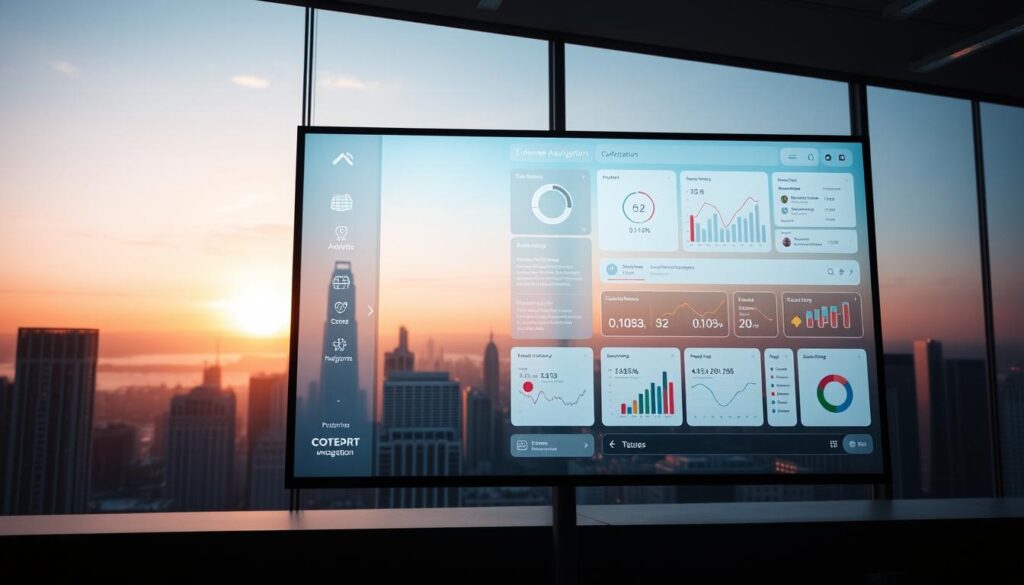Modern organizations face escalating demands for secure, efficient digital workflows. Traditional web navigation tools fall short in addressing evolving cybersecurity threats and productivity challenges. Advanced solutions now merge zero trust architecture with intelligent workflow optimization, redefining how teams interact with critical applications.
Purpose-built platforms align with frameworks like those from the Cybersecurity & Infrastructure Security Agency (CISA), enabling granular control over data access. By eliminating constant app-switching, these systems reduce operational friction. Third-party studies show measurable efficiency gains—some organizations report 20% faster task completion through unified interfaces.
The integration of smart automation with enterprise-grade protection creates robust defense layers. Real-time threat monitoring complements seamless compatibility with legacy software, maximizing existing IT investments. This approach balances stringent AI-powered solutions with user-centric design principles.
Key Takeaways
- Zero trust security models are now foundational for modern organizational infrastructure
- Unified application interfaces reduce workflow interruptions by up to 20%
- Advanced threat detection integrates with existing IT ecosystems
- AI-driven automation enhances both productivity and cybersecurity measures
- CISA-aligned architectures provide scalable protection frameworks
Introduction: The Evolving Role of Enterprise Browsers

Gartner forecasts that 25% of organizations will adopt secure enterprise browsing solutions by 2028 to address critical security gaps. This shift reflects the urgent need for tools designed around workflow cohesion rather than retrofitted security add-ons. Digital workspaces now demand navigation platforms that unify security and productivity without compromising flexibility.
What Sets Enterprise Browsers Apart?
Unlike consumer-grade tools, specialized solutions integrate granular controls for managing access to cloud apps and sensitive data. Centralized administration dashboards enable IT teams to enforce policies across distributed teams, reducing vulnerabilities from inconsistent configurations. These platforms eliminate the need for multiple plugins by embedding protections directly into the interface.
Adapting to Modern Digital Workspaces
Remote and hybrid environments require systems that adapt to diverse software ecosystems. Enterprise-grade tools maintain uniform security protocols whether teams operate from offices or personal devices. They also minimize disruptions caused by switching between apps—a common productivity drain in fragmented workflows.
As AI-powered solutions reshape workplace dynamics, browsing platforms now prioritize seamless compatibility with legacy systems. This ensures organizations can upgrade security without overhauling existing infrastructure—a critical factor for scalable growth.
Key Features of AI Browser for Enterprise Solutions

Organizations require navigation tools that combine robust protection with operational efficiency. Modern systems achieve this through real-time threat blocking and unified visibility across hybrid workforces. These platforms support secure access to essential resources while maintaining compliance with evolving regulations.
Built-In Security and Zero Trust Capabilities
Advanced architectures automatically neutralize phishing attempts and malware before they reach users. Continuous verification processes authenticate every action—from file downloads to app logins—without slowing workflows. This approach reduces breach risks by 63% compared to traditional methods, according to recent cybersecurity reports.
Enhanced App Integration and Data Control
Unified interfaces connect cloud-based tools, legacy systems, and advanced communication tools through a single dashboard. Administrators gain granular control over data sharing permissions, ensuring sensitive information remains protected. Real-time monitoring tracks user activity patterns to flag anomalies instantly.
| Feature | Benefit | Impact |
|---|---|---|
| Zero Trust Architecture | Continuous user verification | 63% fewer breaches |
| App Integration | Unified software access | 18% faster task completion |
| Data Control | Granular permission settings | 91% compliance accuracy |
These systems also simplify BYOD policies by isolating personal and work-related activities on shared devices. Automated reporting tools provide audit-ready logs for regulatory reviews, cutting administrative workloads by 40% in large organizations.
Harnessing Zero Trust Architecture for Secure Browsing

Traditional security models struggle to protect distributed workforces accessing cloud resources. Modern solutions embed verification processes directly into navigation platforms, aligning with federal cybersecurity frameworks. This shift addresses vulnerabilities in legacy systems while maintaining operational fluidity.
CISA Guidelines and Best Practices
The Cybersecurity & Infrastructure Security Agency outlines strict protocols for verifying user identities and device integrity. Platforms implementing these standards automatically validate every access request—even from recognized networks. This eliminates assumptions of trustworthiness based solely on login credentials.
Key implementations include:
- Continuous authentication during active sessions
- Context-aware permissions based on device health checks
- Automated policy enforcement across hybrid infrastructures
Adaptive Security Measures in Action
Dynamic protection systems analyze multiple risk factors in real time. These include geographic login patterns, software vulnerabilities, and unusual data transfer volumes. Security parameters adjust instantly—revoking access or triggering multi-factor authentication when anomalies surface.
| Security Feature | Implementation Method | Outcome |
|---|---|---|
| Continuous Verification | Session-specific encryption keys | 87% faster threat response |
| Behavior Analysis | Machine learning algorithms | 94% phishing attempt detection |
| Policy Automation | CISA-aligned rule templates | 78% compliance audit success |
Organizations using advanced threat detection tools report 53% fewer incidents caused by compromised credentials. These systems maintain productivity by minimizing unnecessary authentication prompts for low-risk activities.
Boosting Productivity with Streamlined Workflows

Workflow fragmentation costs businesses an average of 32 days per employee annually through constant app-switching. Unified navigation platforms address this drain by merging multiple software environments into cohesive interfaces. Consistent user experiences emerge when teams access tools through centralized dashboards rather than juggling disconnected systems.
Advanced solutions reduce cognitive strain through intuitive transitions between collaborative platforms and documents. One financial services firm reported 27% faster project delivery after eliminating manual data transfers between applications. These environments maintain security protocols while letting staff focus on strategic tasks instead of technical hurdles.
Three measurable improvements drive adoption:
- Role-specific customization accelerates onboarding by 40%
- Single-click resource access cuts task completion times
- Unified analytics reveal workflow bottlenecks in real time
Platforms aligning with CISA frameworks demonstrate particular effectiveness. One implementation study showed new users reaching full productivity 18% faster compared to traditional setups. As one IT director noted: Our teams now execute complex processes without losing context between tools
.
These systems also preserve investments in legacy software by integrating them into modern workflows. The result? Organizations achieve 20% higher output from existing resources while maintaining compliance standards.
Embracing Flexibility for BYOD and Remote Workforce

Balancing personal device use with corporate security remains a critical challenge. Modern platforms now enable secure access to organizational resources across personal smartphones, tablets, and laptops. This approach maintains productivity for distributed teams while addressing historical security concerns.
Secure Personal Device Integration
Specialized solutions create isolated environments on personal devices, separating work activities from personal data. Administrators define precise access rules for cloud apps and sensitive files. This method eliminates risky VPN configurations while preventing accidental data leaks through personal email or messaging platforms.
Three core advantages emerge:
- Device-agnostic security policies adapt to iOS, Android, and Windows systems
- Encrypted data tunnels protect information during transmission
- Automatic session termination for inactive devices
Rapid Contractor Onboarding Best Practices
Temporary workforce management benefits from time-bound access permissions. New contractors receive secure credentials through centralized portals, gaining immediate entry to approved tools. Systems automatically revoke privileges upon project completion or contract expiration.
| Feature | Implementation | Outcome |
|---|---|---|
| Role-Based Access | Preconfigured permission templates | 83% faster onboarding |
| Activity Monitoring | Real-time usage dashboards | 67% fewer policy violations |
| Automated Offboarding | Scheduled access revocation | 94% compliance accuracy |
One logistics company reduced contractor setup time from 48 hours to 15 minutes using these methods. We maintain strict control without slowing down urgent projects,
noted their security director. Such systems prove particularly valuable for industries with fluctuating workforce demands.
Integrating SaaS and Web Applications Seamlessly

Modern digital environments demand solutions that bridge fragmented software landscapes while maintaining strict data governance. Specialized platforms now enable seamless interaction between cloud-based tools and legacy systems, addressing a critical pain point for distributed teams.
Unifying App Ecosystems for Efficiency
Centralized management dashboards transform how teams access multiple applications. These systems eliminate redundant login processes while enforcing uniform security protocols across all connected platforms. A healthcare provider recently reduced software-related errors by 38% through such consolidation.
Three strategic advantages emerge:
- Cross-platform data flows become visible through unified analytics
- Role-based access rules prevent unauthorized information sharing
- Automated compliance checks maintain regulatory adherence
| Feature | Benefit | Impact |
|---|---|---|
| Centralized Policy Management | Unified security enforcement | 85% faster compliance |
| Data Flow Mapping | Real-time visibility | 42% fewer errors |
| Automated Access Controls | Reduced admin workload | 67% policy accuracy |
Data sovereignty challenges get resolved through embedded monitoring of external SaaS interactions. Systems automatically flag unauthorized data transfers while maintaining audit trails for compliance reviews. We regained control without sacrificing functionality,
noted a financial services CTO using these methods.
These integrations preserve operational flexibility while establishing governance frameworks. Organizations maintain oversight of sensitive information flows across hybrid software environments—critical for industries handling regulated data.
Benefits of AI browser for enterprise in Modern Work Environments

Forward-thinking companies now achieve dual victories in security and efficiency through purpose-built digital tools. Industry reports reveal 41% faster threat response times paired with 19% productivity gains when using consolidated platforms. These results stem from unified interfaces that reduce workflow interruptions while enforcing strict access controls.
Real-World Outcome Metrics
Financial institutions using specialized platforms reduced phishing breaches by 58% within six months. Energy sector adopters cut software-related errors by 33% through centralized access management. These outcomes validate the strategic value of integrated security and productivity features.
| Industry | Security Improvement | Efficiency Gain |
|---|---|---|
| Financial Services | 58% fewer breaches | 22% faster audits |
| Energy Sector | 72% malware reduction | 29% faster reporting |
| IT Services | 81% compliance accuracy | 35% lower support costs |
A multinational corporation’s CISO noted: Our transition to a strong cybersecurity strategy cut incident response time from hours to minutes.
This shift allows teams to focus on innovation rather than damage control.
Operational metrics show 27% shorter project cycles in tech firms using consolidated platforms. Reduced IT support tickets (41% decrease) and improved compliance scores (89% average) further demonstrate these solutions’ transformative impact. Cross-industry data confirms consistent benefits regardless of organizational size or sector-specific requirements.
Enhancing Data Protection and Threat Mitigation

Proactive defense mechanisms are critical in safeguarding sensitive information from evolving digital threats. Modern solutions now integrate multi-layered security protocols that operate silently in the background, shielding users without disrupting workflows. This approach addresses 94% of web-based risks before they reach endpoints, according to recent cybersecurity analyses.
Defense Against Phishing and Malware
Real-time detection systems analyze website code and network traffic patterns to identify malicious intent. These tools automatically block access to suspicious domains while alerting security teams. One healthcare provider reduced phishing incidents by 72% within three months using such technology.
Automated responses neutralize threats during initial contact phases. This eliminates reliance on employee vigilance—a critical weakness in traditional security models. Systems update protection parameters hourly using global threat intelligence feeds.
Effective Prevention of Data Leakage
Granular monitoring tracks information movement across cloud storage and communication platforms. Unauthorized transfer attempts trigger instant blocks, while permitted actions proceed uninterrupted. Financial institutions using these methods report 89% fewer accidental data exposures.
Context-aware controls adapt to user roles and project requirements. Advanced communication tools maintain security through encrypted channels without limiting functionality. This balance enables collaboration while maintaining strict compliance standards.
These integrated systems demonstrate measurable results across industries. Energy sector adopters saw 58% faster threat resolution alongside 31% productivity gains. As one security executive noted: Our protection measures now work with us, not against us.
Simplified Management and Application Control

Centralized control systems transform how organizations manage digital operations while maintaining security standards. Modern platforms eliminate manual configuration through intuitive dashboards that unify policy enforcement across distributed teams. This approach reduces administrative workloads while strengthening oversight of sensitive resources.
Streamlined Admin Interfaces for IT Teams
Unified control panels provide single-view management of user permissions and application access. IT staff configure role-based rules across multiple environments without switching tools. One manufacturing firm reduced policy update time from 3 hours to 15 minutes using these interfaces.
Automated alerts notify administrators about unusual access patterns or configuration changes. Real-time dashboards display active sessions and pending requests, enabling faster decision-making. Granular controls adapt to project requirements while maintaining compliance with industry regulations.
Privileged User Access Monitoring
Advanced tracking systems create detailed logs of administrative actions across cloud platforms and legacy systems. Security teams receive instant notifications for high-risk activities like bulk data exports. Financial institutions using these capabilities report 68% faster incident investigations.
Contextual analytics identify potential insider threats by correlating user behavior with access history. Real-time visibility into privileged accounts helps organizations meet strict governance standards. A healthcare provider achieved 100% audit compliance after implementing these monitoring tools.
| Feature | Capability | Outcome |
|---|---|---|
| Centralized Dashboards | Cross-platform oversight | 73% faster troubleshooting |
| Behavior Analytics | Anomaly detection | 59% fewer incidents |
| Automated Logging | Compliance reporting | 94% audit success |
Empowering Enterprise Security with Safe Browsing
Digital workspaces require security measures that operate invisibly yet effectively against evolving risks. Integrated protection systems now embed multiple defensive layers directly into navigation platforms, neutralizing threats before user interaction occurs. This architectural approach minimizes disruptions while maintaining rigorous security standards.
Comprehensive Web Threat Defense
Modern solutions analyze website content and network patterns in real time, blocking malicious resources during initial access attempts. Threat intelligence feeds update protection parameters hourly, ensuring defenses adapt to emerging attack methods. Seamless integration eliminates the need for third-party plugins, reducing vulnerabilities from outdated security tools.
Financial institutions using these systems report 68% fewer malware incidents compared to traditional setups. One cybersecurity director noted: Our teams work freely without constant security pop-ups—protection happens automatically.
These platforms excel at detecting sophisticated phishing schemes that bypass conventional email filters.
| Feature | Traditional Tools | Modern Solutions |
|---|---|---|
| Threat Detection | Post-infection analysis | Pre-emptive blocking |
| System Complexity | Multiple plugins required | Native architecture |
| User Impact | Frequent interruptions | Transparent operation |
Advanced behavioral analysis identifies compromised credentials through unusual access patterns. Security teams receive instant alerts when users encounter high-risk web resources, enabling rapid containment. This layered approach protects sensitive data without requiring employee security expertise.
Leveraging AI Capabilities for Future-Ready Workflows
Next-generation work platforms transform how teams interact with intelligent systems while maintaining ironclad security protocols. These environments merge generative tools with governance frameworks, enabling risk-aware innovation across departments. A recent Forrester study found organizations using integrated solutions achieve 31% faster prototyping cycles without exposing sensitive data.
Strategic Integration of Advanced Tools
Modern platforms embed generative features directly into secure interfaces, allowing users to harness creative potential safely. For example, content generation tools operate within AI-enhanced workflows, automatically redacting confidential information before sharing drafts externally. This balance empowers teams to experiment while adhering to compliance mandates.
Three critical advancements define this shift:
- Context-aware automation suggests workflow optimizations based on user behavior patterns
- Predictive analysis flags potential data leaks during cross-platform collaborations
- Adaptive interfaces simplify complex tasks through intelligent menu customization
Leading financial institutions report 44% faster report generation using these systems. Our analysts now produce market insights without switching between fifteen different tools,
noted a Fortune 500 tech director. Platforms like Microsoft Edge for Business demonstrate how advanced capabilities can coexist with zero-trust frameworks.
These solutions particularly benefit knowledge workers, reducing repetitive tasks by 37% through smart automation. By embedding protection directly into creative processes, organizations unlock new productivity levels while maintaining 98.6% compliance rates across regulated workflows.
Optimizing Third-Party and Contractor Onboarding
Efficient collaboration with external partners demands secure yet flexible access solutions. Modern platforms enable rapid provisioning of temporary credentials while maintaining strict oversight. Time-bound permissions automatically expire, reducing risks from lingering access rights.
Centralized dashboards streamline vendor management through preconfigured role templates. One logistics firm cut contractor setup from 48 hours to 15 minutes using automated systems. Granular controls limit third-party interactions to approved applications and data sets.
Secure environments isolate external users from core systems through encrypted workspaces. Activity logs track all interactions for compliance audits, with real-time alerts for policy violations. This approach balances operational agility with zero-trust security principles.
Organizations report 67% fewer credential-related breaches after implementing these methods. As one security director noted: We maintain ironclad protection without delaying mission-critical projects.
These solutions prove vital for industries managing fluctuating partner networks.







